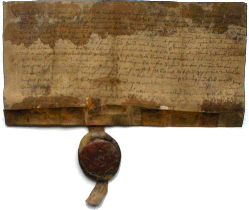![[Clan Crest]](images/Crest%20Colour130.jpg)
Clan MacLea - Livingstone
The Official Home of the Clan McLea (The ancient historical name of the Livingstones)


The Bachuil Charter of 1544
 We received a very curious Charter of Confirmation from Archibald,
the son of Archibald, Earl of Argyll, on 9th April, 1544, confirming
the
grant of lands ‘as freely as the father, grandfather and great-grandfather
and other predecessors of the said John, held the lands of our predecessors,
Lords of Lorn’.
We received a very curious Charter of Confirmation from Archibald,
the son of Archibald, Earl of Argyll, on 9th April, 1544, confirming
the
grant of lands ‘as freely as the father, grandfather and great-grandfather
and other predecessors of the said John, held the lands of our predecessors,
Lords of Lorn’.
Possession since time immemorial
There are several issues here: the first is that this phrase was often used to indicate from time immemorial, but the four generations referred to would account for at least 120 years – so on the most conservative estimate the lands had been held since c1420. It claims that the lands were held from the Lords of Lorn, not the Earls of Argyll. The earldom of Argyll was only created in 1457.
Remember that it was not until 1315 that Robert the Bruce granted to “Sir Colin Cambel, the whole land of Louchaw.. in a free barony .. for the forensic service, of one ship of forty oars for forty days, as often as they shall be forewarned.” This is “Big Colin”. In 1457 his great-grandson, another Colin, became the first Earl of Argyll. One hundred years later they had acquired vast lands.
On the forfeiture of the Lordship of the Isles in 1493 the Crown annexed the land and redistributed it to its favourites. In Alasdair Campbell of Airds History of the Campbells Volume 2 p152 we can see Campbell in 1611 imposing himself as feudal superior to Cameron of Lochiel on the basis that Lochiel had held his lands from the forfeited lordship of the Isles!
The Abbey and the Lordship of Lorn
The second issue is whether these lands were ever part of the lordship of Lorn. In the sixteenth century barony lands and lordships were not necessarily contiguous. The lands could be widely scattered with parcels here and there. According to Professor GWS Barrow Appin literally means “the jurisdiction of, and hence territory owned or ruled by, an ab or abbot, chief dignitary of a monastic community in the pre-twelfth century Celtic Church”. The Coarb of St Moluag will have ruled this land, which at one time was very extensive including the ancient parish of Lismore which embraced Appin. It is unlikely therefore that the abbey lands were ever within the Lordship of Lorn. This is further demonstrated by the fact that the great religious centres were considered Lordships of Regality and, apart from charges of treason, outwith the jurisdiction of the King’s Officers, Sheriff, Earl or Lord.
On the 14 March 1540 the 4th Earl of Argyll received from the King, James V, a renewed grant of all his lands. In 1541 he resigned the Lordship and Barony of Lorn, of which he received a new grant. In 1542 the same lands were resigned and erected anew in favour of Archibald, his heir.
In 1541 he also resigned the lands of Lismore and received a new grant of them. In 1542 the lands of Lismore were again resigned, followed by a re-grant in favour of Archibald, the Earl’s heir. Of interest here is that Lismore was not included in the lands of the Lordship of Lorn, which were resigned separately. To my mind this is an example of “King Campbell” annexing land.
Of particular significance, as pointed out by the Lord Lyon in 1951, is the fact that there was no resignation in the 1544 charter. If Argyll had been feudal superior, the lands would have been resigned to him and then re-granted. This is demonstrated above where we see Argyll resigning his lands and obtaining a new grant from the crown.
Grant of Frankalmoign
But most interesting of all is that this is a confirmation in frankalmoign – which
is impossible.
Once a grant is given in frankalmoign it cannot be confirmed as a grant
of frankalmoign is to God and therefore in mortmain. Therefore the original
granter is unable to intercede or give any grant of confirmation thereafter
as illustrated by Blackstone below.
The 1544 grant of confirmation is “in puram et liberam elimosynam” which translates literally into “in pure and free alms” –i.e. a grant of frankalmoign. This was considered the most exalted of grants and was generally a duty to pray for the granter's soul. Lands held under frankalmoign were subject only to ecclesiastical courts and enjoyed other benefits.
“ Gifts to the religious in free alms were defined as being primarily to God, then to the saint of the patrimony of the religious house, and then to the earthly persons serving God there”.
[The Charter of 1544 follows this format exactly “in honour of God Omnipotent, the blessed Virgin, and Saint Moloc, our patron, have mortified and by the present writing confirmed, to our beloved pursuivant, John McMolmore Vic Kevir”]
“ Several consequences flowed from that statement: (i) the religious could recognise no secular lord; (ii) the gift, being primarily to God and the Saint, and in wider terms the Church, was inalienable, and thus in mortmain; (iii) since the relationship between earthly persons, grantor and religious, was only secondary, no tenurial relationship was possible.”
Blackstone's Commentaries on the Laws of England
“ V.TENURE in frankalmoign, in libera eleemosyna, or free alms, is that, whereby a religious corporation, aggregate or sole, holdeth lands of the donor to them and their successors forever. The service, which they were bound to render for these lands was not certainly defined; but only in general to pray for the souls of the donor and his heirs, dead or alive; and therefore they did no fealty, (which is incident to all other services but this) because this divine service was of a higher and more exalted nature. … And, even at present, this is a tenure of a nature very distinct from all others; being not in the least feudal, but merely spiritual.”
All this supports Lord Lyon Sir Thomas Innes of Learney’s view that the Coarbs had no superior.
“ a so-called ‘charter’ from Archibald, Master of Argyll, on behalf of his father, the Earl of Argyll and Lord of Lorne, in favour of their signifier, viz. pursuivant (not " standard bearer ") John Mc Mollemore vic Evir, dated 9th April 1544. This confirmed the lands along with the keeping of the Bachuil …..which are declared to have been held by the father, grandfather, great-grandfather and other predecessors of the said John. The instrument is therefore one of confirmation for it contains no resignation and constitutes evidence of immemorial heritable possession of the lands and the keeper- ship of the staff.”
He continues
“ Now the essence of the character of a Coarb, demonstrated by Professor Coulton and by the subsequent history of both the Quigerich and the Bachuil, is that these successors, the "heirs" or Coarb of St Moluag and St Fillan have themselves come down through the centuries also "acknowledging no earthly authority or hierarchy". That, in my view, is why the Bachuil lands had no feudal superior in the Middle Ages and why the tenure was essentially analogous to that which was also characteristic of the glebe until the Act of 1925. And the Baron of the Bachuil at first like certain old French barons, was in the nature of a "baron par le grâce de Dieu". No evidence is adduced that the Bachuil and Bachuil-land were ever held “of or under " the Bishop of Lismore, and I do not believe that this was the case. In my view it would have been incompatible with the fundamental nature of the thing, and of being the Coarb of the Saint. The same evidently applies to the Quigerich of St Fillan : it was indeed declared independent.”
Furthermore, certainly in England, lands granted in frankalmoign were
subject to Church Law, not the Kings law.